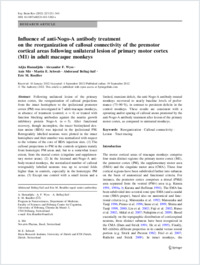Influence of anti-Nogo-A antibody treatment on the reorganization of callosal connectivity of the premotor cortical areas following unilateral lesion of primary motor cortex (M1) in adult macaque monkeys
- Hamadjida, Adjia Department of Medicine, Faculty of Sciences, University of Fribourg, Switzerland
- Wyss, Alexander F. Department of Medicine, Faculty of Sciences, University of Fribourg, Switzerland
- Mir, Anis Novartis Pharma, Basel, Switzerland
- Schwab, Martin E. Brain Research Institute, University of Zürich and ETH Zürich, Zürich, Switzerland
- Belhaj-Saïf, Abderraouf Department of Medicine, Faculty of Sciences, University of Fribourg, Switzerland
- Rouiller, Eric M. Department of Medicine, Faculty of Sciences, University of Fribourg, Switzerland
-
2012
Published in:
- Experimental Brain Research. - 2012, vol. 223, no. 3, p. 321-340
English
Following unilateral lesion of the primary motor cortex, the reorganization of callosal projections from the intact hemisphere to the ipsilesional premotor cortex (PM) was investigated in 7 adult macaque monkeys, in absence of treatment (control; n = 4) or treated with function blocking antibodies against the neurite growth inhibitory protein Nogo-A (n = 3). After functional recovery, though incomplete, the tracer biotinylated dextran amine (BDA) was injected in the ipsilesional PM. Retrogradely labelled neurons were plotted in the intact hemisphere and their number was normalized with respect to the volume of the core of BDA injection sites. (1) The callosal projections to PM in the controls originate mainly from homotypic PM areas and, but to a somewhat lesser extent, from the mesial cortex (cingulate and supplementary motor areas). (2) In the lesioned anti-Nogo-A antibody-treated monkeys, the normalized number of callosal retrogradely labelled neurons was up to several folds higher than in controls, especially in the homotypic PM areas. (3) Except one control with a small lesion and a limited, transient deficit, the anti-Nogo-A antibody-treated monkeys recovered to nearly baseline levels of performance (73–90 %), in contrast to persistent deficits in the control monkeys. These results are consistent with a sprouting and/or sparing of callosal axons promoted by the anti-Nogo-A antibody treatment after lesion of the primary motor cortex, as compared to untreated monkeys.
- Faculty
- Faculté des sciences et de médecine
- Department
- Département de Médecine
- Language
-
- English
- Classification
- Biological sciences
- License
-
License undefined
- Identifiers
-
- RERO DOC 31014
- DOI 10.1007/s00221-012-3262-x
- Persistent URL
- https://folia.unifr.ch/unifr/documents/302619
Statistics
Document views: 89
File downloads:
- Fichier principal: 144
